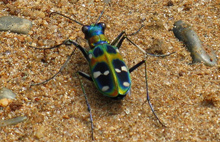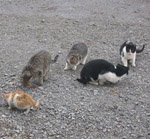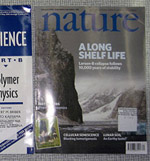Can flightless insects cross roads?
 Invertebrates,
Invertebrates,  Protected Areas
Protected Areas  Japanese tiger beetle (Cicindela japonica), a carabid beetle. Image credit, KENPRoads can have a variety of negative impacts on wildlife - through fragmentation of habitat, road kill, physical barriers and so forth. This is especially true for insects such as ground beetles that have limited dispersal abilities. Past research has shown that wide paved roads can disrupt the movement of carabid beetles likely to their detriment. However, few studies have yet to look at how narrow unpaved roads affect ground beetle movement. Understanding how narrow, dirt roads affect species movement is especially important in the context of protected areas and other lands where resource managers oversee the construction and maintenance of extensive road networks.
Japanese tiger beetle (Cicindela japonica), a carabid beetle. Image credit, KENPRoads can have a variety of negative impacts on wildlife - through fragmentation of habitat, road kill, physical barriers and so forth. This is especially true for insects such as ground beetles that have limited dispersal abilities. Past research has shown that wide paved roads can disrupt the movement of carabid beetles likely to their detriment. However, few studies have yet to look at how narrow unpaved roads affect ground beetle movement. Understanding how narrow, dirt roads affect species movement is especially important in the context of protected areas and other lands where resource managers oversee the construction and maintenance of extensive road networks.
In a new study, researchers investigated the movement and habitat use of carabid beetles in the Nopporo Forest Park in Hokkaido, Japan. They looked at 4 types of roads: a) 3.5 meter width, abandoned dirt road overgrown with grass and bamboo, b) 3.5 meter width, gravel road, closed to public, c) 4.5 m width, gravel road open to public, d) 4.5 meter width paved road open to public. They set-up dry pit-fall traps and marked and released captured beetles. The study recorded the number of ground beetles by species that they captured on both sides of the road and compared the results against what would be predicted if the road wasn't a barrier.
The researchers found that for one of the dominant forest inhabiting species at the study site, Leptocarabus arboreus ishikarinus, all four road types inhibited the beetle's dispersal ability. They found that for all the beetles, an increase in road width and the presence of surface pavement had a negative effect on the road-crossing rate. The researchers speculated that carabid beetles crossing asphalt and wide roads are conspicuous to predatory birds negatively impacting dispersal success. Based on these results, the researchers drew the following conclusions,
"This study suggests that even narrow roads that pass through a forest have a negative effect on the movement of forest-inhabiting carabid beetles. Our results suggest that the harmful effect tends to increase as the width of the road increases and with the presence of pavement on the road."
The study authors recommend that resource managers take these impacts into consideration when planning the construction and maintenance of roads.
| Source: | Journal of Insect Conservation |
| Title: | Effects of narrow roads on the movement of carabid beetles (Coleoptera, Carabidae) in Nopporo Forest Park, Hokkaido |
| Authors: | a, b) Yoshiki Yamada, a) Hitoshi Sasaki and b) Yutaka Harauchi |
| a) Rakuno Gakuen University, Japan, b) Dokon Co. Ltd., Japan |




Reader Comments